Religious communities have deep and diverse roots
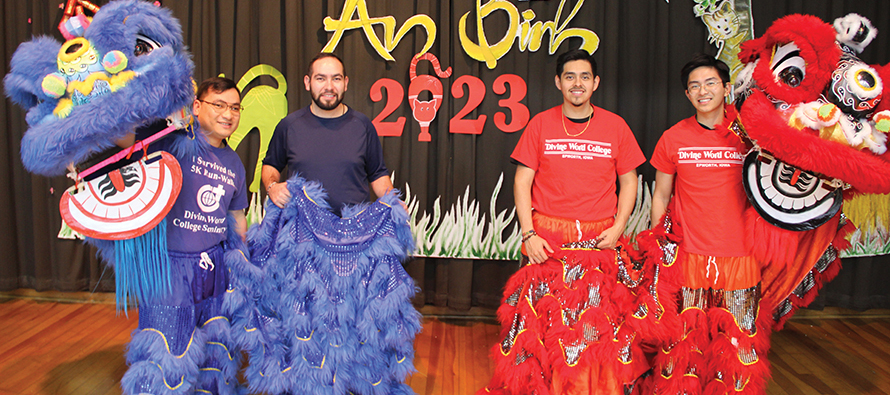
Students at Divine Word College who were on the 2023 Lion Dance team, part of the college’s annual celebration of the Lunar New Year. The college is run by the men’s missionary community, Society of Divine Word. (Photo courtesy of Divine Word College)
FOR NEARLY 2,000 years, religious life has developed and shape-shifted while always staying true to its mission of discipleship. As the world has grown more interconnected, so too has religious life taken on an increasingly global character.
All of the following communities are located in the United States, but their cultural heritage comes from around the globe. Some of these are religious institutes that came here from Europe to serve Catholic immigrants. Others are U.S.-initiated communities with members who represent the many cultures within the country. They incorporate their ethnic and cultural strands in their worship, community life, ministry, and more. Their members are proud of their multiethnic heritage, and they find many ways to celebrate it. Food, dance, song, prayer, art—nothing is spared when these sisters, priests, and brothers honor their roots.
Dragon dance comes to Iowa
Each spring, Divine Word College, a Catholic missionary college in Epworth, Iowa sponsored by the Society of Divine Word, celebrates the Lunar New Year, or Tết, as it is known in Vietnamese (see photo at top). Since 1976, the college’s celebration has brought together the diverse cultures of the student body to honor a holiday typically celebrated in Asian cultures. Hispanic students are just as likely to perform the traditional Lion Dance as Vietnamese students. The 2023 Lion Dance team consisted of a Vietnamese student, two Hispanic students, and a Filipino student. In addition to the Lunar New Year, the college has annual celebrations of the feast of St. Josephine Bakhita, Our Lady of the Americas, and Mission Sunday. In each celebration, members of the nearly 20 cultural groups in the student body of Divine Word College come together to learn and grow from one another.
—Divine Word Missionaries
An Irish blessing
“I grew up in Ireland,” says Sister Helen Cahill, F.M.O.L., “and was impressed by missionaries who came to visit our school and tell us of their work. It was then that the seeds were sown for me to become a sister.” For many years Cahill was an oncology nurse, and today she is a chaplain in a mental and behavioral health unit. “I admire the strength and courage it takes to deal with emotional pain,” she says. See the video above of Cahill delivering a traditional Irish blessing.
—Franciscan Missionaries of Our Lady
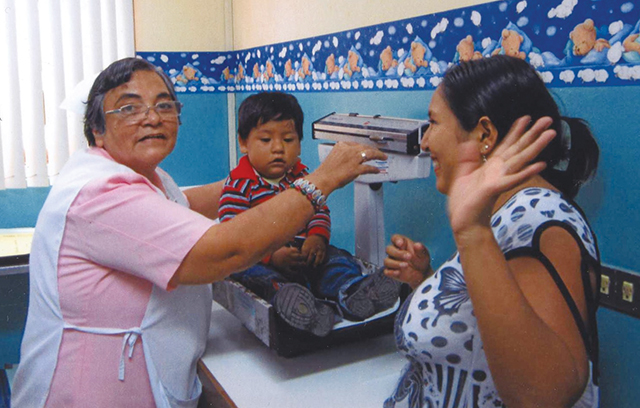
Church is a universal calling
“As I discerned my Franciscan vocation,” says Sister Caryn Crook, O.S.F., “I participated in many liturgies that grabbed my attention and heart. They began when Sister Edward Marie blew on the conch shell as a call to worship, ribbons waved in the air, and there were hulas and songs in Spanish and Hawaiian. They captivated me and deepened my understanding of my Catholic faith as church universal. That was 18 years ago. We no longer blow the conch shell before liturgies, but the feeling of church universal remains.”
The conch shell was a tradition tied to Hawaii, where the community has served for generations, beginning with efforts to aid those with leprosy.
“More than ever, we must now take every opportunity to know other cultures, learn to appreciate them and understand the importance and richness of interculturality. Cultural diversity is a vehicle for development, social cohesion, and peace. It makes us more open and understanding because it gives us meaning, makes us unique, and encourages us to share,” says Crook.
“Putting ourselves in someone else’s shoes does not mean becoming the other person; it is for understanding more than just one point of view. Today our sisters continue to learn and grow in honoring God’s wonderful, diverse creation.”
—Sisters of St. Francis of the Neumann Communities

Not by bread alone
“When I joined a religious community founded in the United States by Slovak immigrants,” says Sister Deborah Borneman, SS.C.M., “I expected to enjoy delicious ethnic dishes and desserts like halushki, pierogies, poppyseed bobalki, and fruit kolache. After all, growing up in the ethnic neighborhoods of Pittsburgh I attended many parish festivals with these doughy delights. What I was surprised to learn was that these meatless meals would become regular Friday suppers because we abstain from meat (or engage in acts of charity) every Friday for the intention of world peace. In fact, during my very first visit to the community I was served a simple plate of cheese-filled pierogies.
“The ethnic traditions within our Saints Cyril and Methodius community,” says Borneman, “have been passed along through the decades from sister to sister. One is the custom of placing a statue of Saint Joseph in the convent food pantry. As a provider, Saint Joseph ensures that the cupboard shelves will not grow bare. I myself have a beautiful wooden carved image of the Holy Family that sits on the kitchen shelf. It is a visual reminder to pray for our sisters and brothers who lack consistent access to food in order to live active, healthy lives.”
—Sisters of Saints Cyril and Methodius
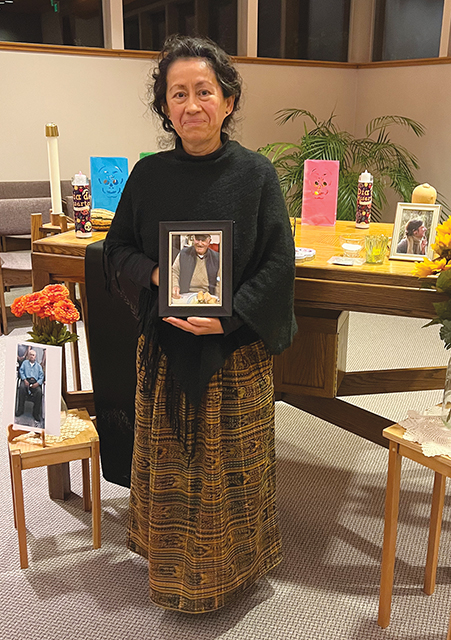
Honor your ancestors
The Benedictine Sisters of Saint Placid Priory in Lacey, Washington celebrate Day of the Dead, an important festival in Mexican and Mexican-American culture. The history of the festival stretches back to pre-conquest Mexico when the celebration of one’s ancestors among indigenous peoples would last more than a month. After the Spanish conquest and evangelization of Mexico, church officials encouraged a blending of the indigenous and Catholic customs on November 1, All Saints Day (which is followed on November 2 with All Souls Day).
“The Day of the Dead is not just a day to remember and honor our dead, but also a day to protest,” says Sister Paz Vital, O.S.B. “I choose to protest for the migrants’ conditions and the children’s separation from their parents. At St. Placid in our petitions we remember the children and their parents and all the people at the border waiting for their petitions to be answered.”
—Benedictine Sisters, Lacey, WA, St. Placid Priory
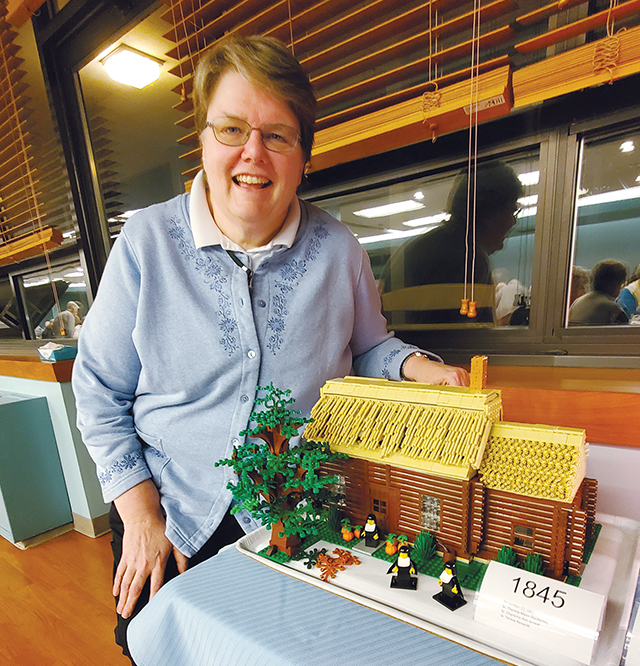
Giving religious education a Lego up
Sister Elizabeth Ann DeMerchant, I.H.M. used Legos to build a replica of the log cabin in which the three original members of her religious community lived in the mid-1800s. Her use of art to teach religion and history is firmly within the tradition of the community. The Sisters, Servants of the Immaculate Heart of Mary, Scranton was co-founded by a Redemptorist priest and Oblate Sister of Providence and then I.H.M. Sister Theresa Maxis Duchemin. The Redemptorist priests passed along their use of art and music as teaching tools.
The Lego log cabin has not been DeMerchant’s only creation. She regularly uses Legos and projects of STREAM (Science, Technology, Religion, English, Art, and Math) to teach religion at All Saints Academy in Scranton, Pennsylvania.
—Sisters, Servants of the Immaculate Heart of Mary, Scranton, PA

Worldwide witnesses of love
A priest from Indonesia, Cameroon, and Texas walk into a church . . . . It sounds like the opening line to a tacky bar joke. But on the Lower Brule and Crow Creek reservations in South Dakota, it’s just another weekend Mass. Served by the Priests of the Sacred Heart (also called the Dehonians), the Lower Brule Pastoral Ministry Team includes priests from these diverse backgrounds. Other ministries of the Priests of the Sacred Heart are run by teams of priests and brothers with similarly varied ethnicities and cultures.
Since their beginnings in the late 1800s in France—where they were founded to address the needs of the poor and challenge social injustice—this congregation of missionary priests and brothers has established ministries in more than 40 countries. Their mission is to be witnesses of God’s transforming love in souls and society and to spread God’s love around the world with open heart and mind.
—Priests of the Sacred Heart (Dehonians)
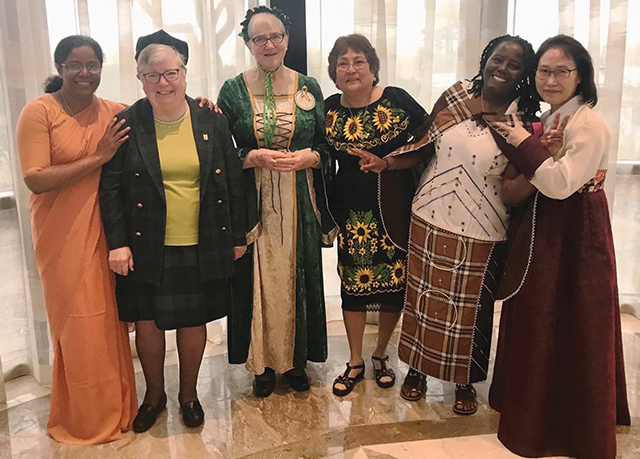
(Photo: Sister Jo-Anne Miller, C.S.J.P.)
Reordered borders
The membership of the Sisters of St. Joseph of Peace has changed from its founding days in 1884 in Nottingham, England. For many years, it received members from Canada, Ireland, England, and the United States. More recently, the community has welcomed new members from beyond the usual borders, including from India, Kenya, and Korea.
“The acknowledgment and realization of how racial bias has led to biased membership decisions and white privilege continue to impact the congregation and are still a work in progress since 2011,” writes Sister Jo-Anne Miller, C.S.J.P. The openness to acknowledge the emerging diversity of our C.S.J.P. membership has led to demanding a change of heart to be, think, and act differently.”
—Sisters of St. Joseph of Peace
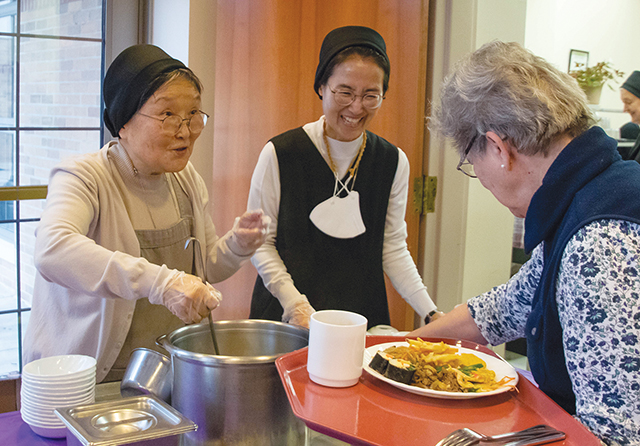
Transpacific trade
The Sisters of Charity of Seton Hill, Pennsylvania, have a province in Korea with sisters serving in 11 dioceses there. Each winter native Korean members of that province lead an annual celebration of the Lunar New Year at the U.S. province motherhouse. Called Seollal, the celebration involves food, games, and ancestral rites. After the festivities, the Korean sisters pay respect to their elders by taking a deep bow called se-bae. In return, the sisters who live in the U.S. motherhouse offer blessings and thanks in song and applause for deepening interculturality in the community.
—Lynn Wagner, Sisters of Charity of Seton Hill, PA
Cultures cherished, communities strengthened
From a small group of women reaching out to the poor in Germany in the mid-1800s, the Poor Handmaids of Jesus Christ have become an international congregation present in nine countries.
“Each [has] its own distinctive culture, language, and accent when [we] speak English,” says Sister Edith Schneider, P.H.J.C. “We are beginning to experience changing structures which will bring us more opportunities to live interculturally and to cherish community bonds with sisters from varied ethnic backgrounds.”
“We look forward with hope to continued growth as a congregation,” she continues. Listen (above) to the community singing a Spanish and English song.
—Sister Connie Bach, P.H.J.C., Poor Handmaids of Jesus Christ
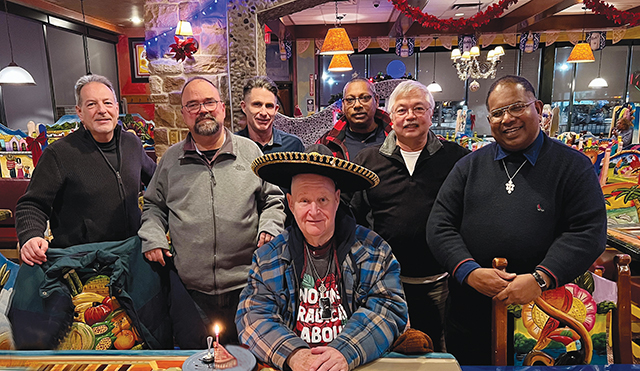
Ties that bind
The Alexian Brothers’ community includes men from a variety of cultural and ethnic traditions. Brother Exequiel Mapa, C.F.A. says, “Making little, conscious efforts to come together and uniquely recognize individuals on special days helps us establish closer relationships.” Special days might be feast days, birthdays, or other milestones.
—Congregation of Alexian Brothers
Adding music to the mix
“I am a second-generation Mexican American whose roots are in deep South Texas,” says Brother Ignacio González, O.S.B., oblate director for his Benedictine community. “My monastery is in our nation’s capital. My heritage enriches the community because of the 12 of us monks, I am the only one of Hispanic descent, and my understanding of the faith is rooted in Mexico’s 500-year-old tradition of honoring our Lord Jesus through La Virgen de Guadalupe.” In the above video, González sings a hymn in Spanish.
—Benedictine Monks, Washington, DC, St. Anselm’s Abbey
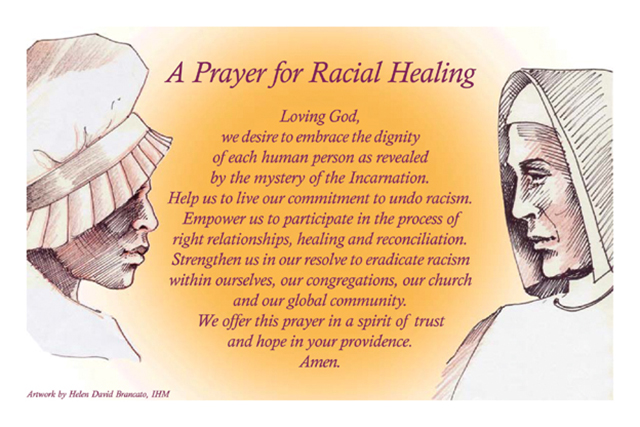
Acknowledging and healing past sins
More than 177 years ago, the Sisters, Servants of the Immaculate Heart of Mary (I.H.M.) were founded in Monroe, Michigan by Mother Theresa Maxis Duchemin, O.S.P. and Father Louis Florent Gillet, C.Ss.R. a Redemptorist priest and Belgian immigrant. Duchemin was a U.S.-born biracial woman, daughter of a Haitian refugee and a British military officer. Duchemin was involved in the beginnings of two religious congregations: first the Oblate Sisters of Providence in Baltimore and then, when the demise of the Oblate Sisters seemed imminent, the Sisters, Servants of the Immaculate Heart of Mary. Duchemin set aside her identity as a woman of color and established herself in the white community. For many years Theresa’s ethnic heritage was muted within the congregation. Her background, however, was known to the bishops, and ultimately it became an underlying motivation for her expulsion from the I.H.M. congregation in Monroe.
The subsequent split of the local communities in Monroe and Pennsylvania led to the establishment of the three autonomous I.H.M. congregations that still exist today: Monroe, Scranton, and Immaculata. Along with our Oblate Sisters in Baltimore, we Sisters of I.H.M. own and openly admit that the dynamics of racism influenced our beginnings and impacted the unfolding of our four histories. Therefore, we commit ourselves to the work of undoing racism. On the eighth day of each month, we pray together “A Prayer for Racial Healing.”
—Sister Candyce Rekart, I.H.M., Sisters, Servants of the Immaculate Heart of Mary, Monroe, MI
Heritage in reel life
The Sisters of St. Mary of Oregon are captured on video (below) celebrating the Vietnamese New Year with traditional attire, dance, and cuisine.
The Sisters of Charity of Nazareth, Kentucky share videos used during the congregation’s Foundation Day celebration. The videos below show a sharing of the soil symbolizing the connectedness of their various global ministries, and prayer is also carried out in different languages and styles.

Global reach
Although the Sacred Heart Seminary & School of Theology may not have begun with a mission to bring together people from around the world, today that is a reality for the students. Recent students have come from the United States and 35 other countries. The seminary and school educate both clergy and lay students in Franklin, Wisconsin. In addition to preparing men for ordination in the Catholic church, the seminary and school offer programs for laity, those involved in Hispanic ministry, men over age 30 considering priesthood, and more. The seminary and theology school are sponsored by the Priests of the Sacred Heart.
—Sacred Heart Seminary & School of Theology
Tags
Related
- Literature makes good people better
- Icons: An age-old entrée into the divine
- Scientific wonder is God’s handiwork
- Respite and renewal brought to you by religious communities
- Lives that lead to God: Biographies and memoirs
- Religious orders aid and advocate for migrants
- Rural religious take to the highways and byways
- Divine design: The holiness of place
- More prayer spaces of religious communities
- Word as witness to the Word Read More
Most Viewed
- Find your spirituality type quiz
- Questions and answers about religious vocations
- Celibacy quiz: Could I be a nun? Could I be a brother? Could I be a priest?
- Resources for older discerners or those with physical and developmental differences
- About Vocation Network and VISION Guide

